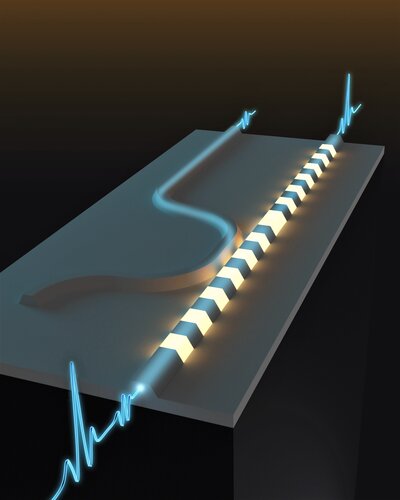An optical switch developed by Caltech researchers harnesses the property of optical nonlinearity and aims to enable ultrafast all-optical signal processing and computing. According to its developers, the technology could help to bypass one of the major limitations of optics-based computing — the need to use electronics-based transistors to process data.
Although optical nonlinear functions enable applications in integrated photonics, including all-optical information processing and photonic neural networks, most nanophotonic platforms demonstrate weak native nonlinearity. This barrier necessitates large driving energies, high-Q cavities, or integration with other materials with stronger nonlinearity, the researchers said.
The on/off property of switches is the foundation of logic gates and binary computation and is the purpose for which transistors were designed. Achieving the same feat with light has proven difficult. Unlike electrons in transistors, which can strongly affect each other’s flow and thereby cause “switching,” photons usually do not easily interact with one another, the researchers said.

An artist's illustration of an optical switch, splitting light pulses based on their energies. A team at Caltech developed a nonlinear splitter in which the light pulses are routed to two different outputs, based on their energies. The dynamic enabled switching to occur in less than 50 fs. Courtesy of Caltech.
The team led by Alireza Marandi, assistant professor of electrical engineering and applied physics at Caltech, developed its switch using lithium niobate. Because of the way that atoms are arranged within the crystalline material, the optical signals that it produces as outputs are not proportional to the input signals.
Recent advancements in nanofabrication techniques enabled the team to create lithium niobate-based integrated photonic devices that allow for the confinement of light in a very small space. The smaller the space, the greater the intensity of light — though the power remains the same. As a result, the pulses of light carrying information through such an optical system could provide a stronger nonlinear response than would be possible otherwise.
The team also decreased the duration of light pulses and used a specific design to keep the pulses short as they propagate through the device, resulting in each pulse having higher peak power. This tactic confined the light temporarily.
The team then combined the two tactics to substantially increase the strength of nonlinearity for a given pulse energy, which means the photons now affect one another much more strongly.
The net result was a nonlinear splitter in which the light pulses are routed to two different outputs based on their energies, which enabled switching to occur in less than 50 fs.
By comparison, state-of-the-art electronic switches take tens of picoseconds.
The research was published in Nature Photonics (www.doi.org/10.1038/s41566-022-01044-5).